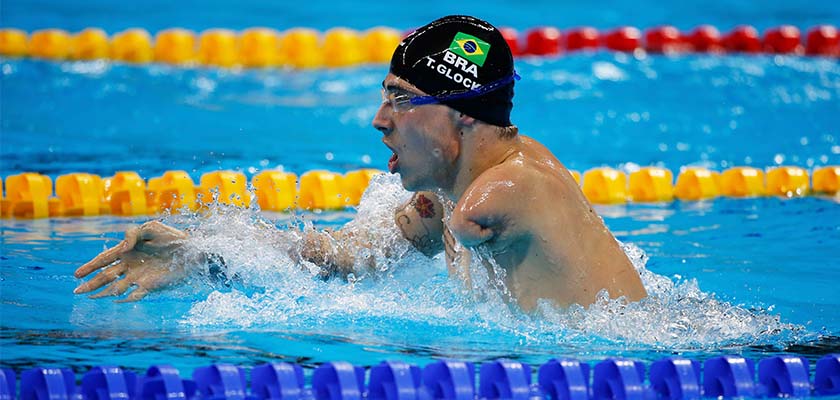You’ve already seen everything about Paralympic swimming, such as its history and even the main athletes. It’s time, then, to get to grips with the paralympic swimming rules. We’ve listed them all in a comprehensive guide. Get all your questions answered.
Participate in our free WhatsApp community and receive daily tips, news and trivia from over 50 sports! Click here to join.
Paralympic swimming rules: general
In general, the rules of paralympic swimming are very similar to those of the traditional sport. Swimmers must touch the pool wall with any part of their body at the end of each leg of the race, turning around to start the next leg.
Swimmers may not push off the pool wall with their feet during the turn, and must remain within their respective lanes throughout the race, not crossing over into neighbouring lanes.

Paralympic swimming rules: types of stroke
Among the types of swimming in Paralympic swimming, there are four main ones: crawl, backstroke, breaststroke and butterfly. Below you’ll find more details on the rules of each. Each style of swimming requires specific skills from the swimmers.
Crawl
The crawl stroke in paralympic swimming is performed with the athlete lying face down in the water. They must keep their body aligned and extended as much as possible to minimize water resistance.
In the movement, the arms alternate, where one arm is extended forward in the water while the other is pulled back. During the pull phase, swimmers can use the strength of their trunk and upper limb muscles to generate propulsion.
Breaststroke
The swimmer starts the race lying face down in the water. During the stroke and kick, the swimmer keeps their body aligned horizontally.
During the race, the swimmer may not perform simultaneous leg movements, except during the turn and the finish. The swimmer must touch the pool wall with both hands simultaneously at the end of each leg of the race.
Arm and leg movements must occur simultaneously and alternately, without irregular or discontinuous movements.
Backstroke
In the backstroke, the swimmer starts the race lying on their back in the water, with their body aligned horizontally. Throughout the race, the swimmer remains on their back, without turning forward at any time.
During the race, the swimmer may not touch the side lanes or the center line of the pool, and may not make simultaneous leg movements, except during the turn and finish.
Butterfly
In the paralympic butterfly swim, the swimmer starts the race lying face down in the water. During the swim, the body remains aligned horizontally, with the hips on the surface of the water.
Medley
There’s also medley swimming, which combines the four different styles of swimming in a single race.
Regras da natação paralímpica: distâncias
The distances in Paralympic swimming are similar to those in conventional swimming and range from shorter events, such as the 50 meters, to longer events, such as the 1500 meters. They can include:
- 50 meters: swimmers compete in a single leg of the pool.
- 100 meters: swimmers complete two legs of the pool.
- 200 meters: swimmers complete four legs of the pool.
- 400 meters: swimmers complete eight legs of the pool.
- 800 meters: swimmers complete 16 legs of the pool.
- 1500 meters: swimmers complete 30 legs of the pool.
In addition to the standard distances, paralympic swimming can also include relay races, where swimmers compete in teams and pass each other a baton as they swim.

Paralympic swimming rules: who can take part?
To take part in Paralympic swimming and apply for Paralympic competitions, athletes must meet the eligibility criteria established by the International Paralympic Committee (IPC).
Athletes must have a physical, visual or intellectual disability. The disability must substantially affect one or more areas of physical, sensory, intellectual or mental functioning.
Paralympic swimming rules: disabilities and classes
The classes in Paralympic swimming are divided by the athlete’s degree of disability. Each class has a letter (type of swimming) and a number (degree of impairment).
- S + athlete’s class number (backstroke and butterfly);
- SB + athlete’s class number (breaststroke);
- SM + athlete’s class number (medley swimming).
It’s worth noting that the higher the level of commitment, the lower the class number. The division is as follows:
- Classes 1 to 10: athletes with physical-motor limitations
- Classes 11 to 13: visually impaired athletes
- Class 14: athletes with intellectual disabilities
Paralympic swimming rules: scoring
The score in Paralympic swimming is determined mainly by the times obtained by the swimmers in their individual events.
Just as in conventional swimming, Paralympic swimmers’ times are recorded in each individual event. Times are measured precisely, usually to hundredths of a second, using electronic timing systems.
After the completion of the individual events, the swimmers’ times are compared within their functional classification classes. There’s no secret: the swimmers with the fastest times in each event receive a higher score.
Scoring System
The paralympic swimming scoring system is based on a points scale where the swimmer with the fastest time in an event receives a higher score, and the other swimmers receive lower scores depending on their positions in the event.
Now that you know all the rules of Paralympic swimming, you can cheer with confidence and follow the events. Be sure to check out our content to learn more about the world of sports:



